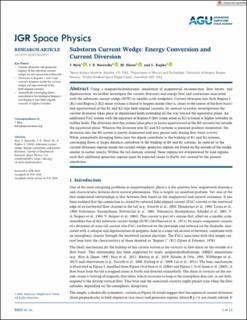| dc.description.abstract | Using a magnetohydrodynamic simulation of magnetotail reconnection, flow bursts, and dipolarization, we further investigate the current diversion and energy flow and conversion associated with the substorm current wedge (SCW) or smaller-scale wedgelets. Current diversion into both Region 1 (R1) and Region 2 (R2) sense systems is found to happen inside (that is, closer to the center of the flow burst) and equatorward of the R1 and R2 type field-aligned currents. In contrast to earlier investigations the current diversion takes place in dipolarized fields extending all the way toward the equatorial plane. An additional FAC system with the signature of Region 0 (R0) (same sense as R2) is found at higher latitudes in taillike fields. The diversion into this system takes place in layers equatorward of the R0 currents but outside the equatorial plane. Whereas the diversion into R1 and R2 systems is pressure gradient dominated, the diversion into the R0 system is inertia dominated and may persist only during flow burst activity. While azimuthally diverging flows near the dipole contribute to the buildup of R1 and R2 systems, converging flows at larger distance contribute to the buildup of R0 and R1 systems. In contrast to the current diversion regions inside the current wedge, generator regions are found on the outside of the wedge, similar to earlier results. Within the tail domain covered, these regions are overpowered by load regions, such that additional generator regions must be expected closer to Earth, not covered by the present simulation. | en_US |
